Futures prop trading in 2025 is all about speed, flexibility, and global competition. Here’s what you need to know:
- Same-day payouts are now the norm, with firms like FundingTicks leading the charge.
- Ultra-low latency (0-1ms) via VPS hosting is critical for fast execution on platforms like NinjaTrader and TradeStation.
- Evaluation costs range from $99 to $599, with account sizes from $25,000 to $300,000.
- UAE-based firms like FundingTicks and FundedNext Futures are shaking up the market, competing with established U.S. players like Apex Trader Funding.
- Traders benefit from clear rules, high profit splits (up to 90%), and tailored education.
Futures Prop Firms: A Quick Comparison
| Firm | Founded | Account Sizes | Evaluation Fees | Payout Speed | Profit Split |
|---|---|---|---|---|---|
| FundingTicks | 2025 (UAE) | $25K-$100K | $99-$599 | Same-day | 80%-90% |
| FXIFY Futures | 2023 (UK) | $25K-$100K | $89-$349 | Immediate | 80%-90% |
| FundedNext Futures | 2025 (UAE) | $25K-$100K | $129-$449 | Same-day | 80%-90% |
| Tradeify | 2024 (US) | $25K-$150K | Varies | Immediate | 80%-90% |
| My Funded Futures | 2023 (US) | $25K-$150K | Varies | Weekly | 80%-90% |
| Take Profit Trader | 2021 (US) | $25K-$150K | Varies | Immediate | 80%-90% |
| Topstep | 2012 (US) | $50K-$150K | $49-$149/month | Weekly | Varies |
| Lucid Trading | 2025 | $25K-$150K | $79-$299 | Weekly/Same-day | 80%-20% |
| TradeDay | 2020 (US) | Varies | Varies | Weekly | Varies |
| Apex Trader Funding | 2021 (US) | Varies | Varies | Weekly | Varies |
| The Futures Desk (UK) | Unknown | $25K-$200K | $134-$539 | Weekly | Varies |
Key takeaway: Choose a firm with fast payouts, fair fees, and strong tech support to align with your trading goals.
Compared to other prop firms, these options often provide faster payout speeds, better technology, and more responsive support.
What is a Prop Firm? (Prop Trading Basics)
A prop firm, short for proprietary trading firm, is a company that empowers traders to access the financial markets—like futures trading—using the firm’s own capital. Instead of risking their own money, traders can leverage the resources of the prop firm to pursue trading success. This setup allows traders to focus on developing their trading skills and strategies, while the firm provides the capital, advanced trading platforms, and robust risk management tools needed to navigate the markets.
Prop firms are designed to support traders at every stage, offering a variety of accounts such as cash accounts and simulated funded accounts. These accounts cater to different trading styles and experience levels, giving traders the flexibility to choose what best fits their goals. With access to leverage, dedicated support teams, and a range of trading assets, prop firms create an environment where traders can maximize their potential and work toward becoming consistently profitable. Ultimately, the goal of a prop firm is to help traders achieve trading success, manage risk effectively, and grow as professionals in the fast-paced world of futures trading.
Ultimate Futures Prop Firm Tier List 2025 (From A 7 Figure Trader)
1. FundingTicks
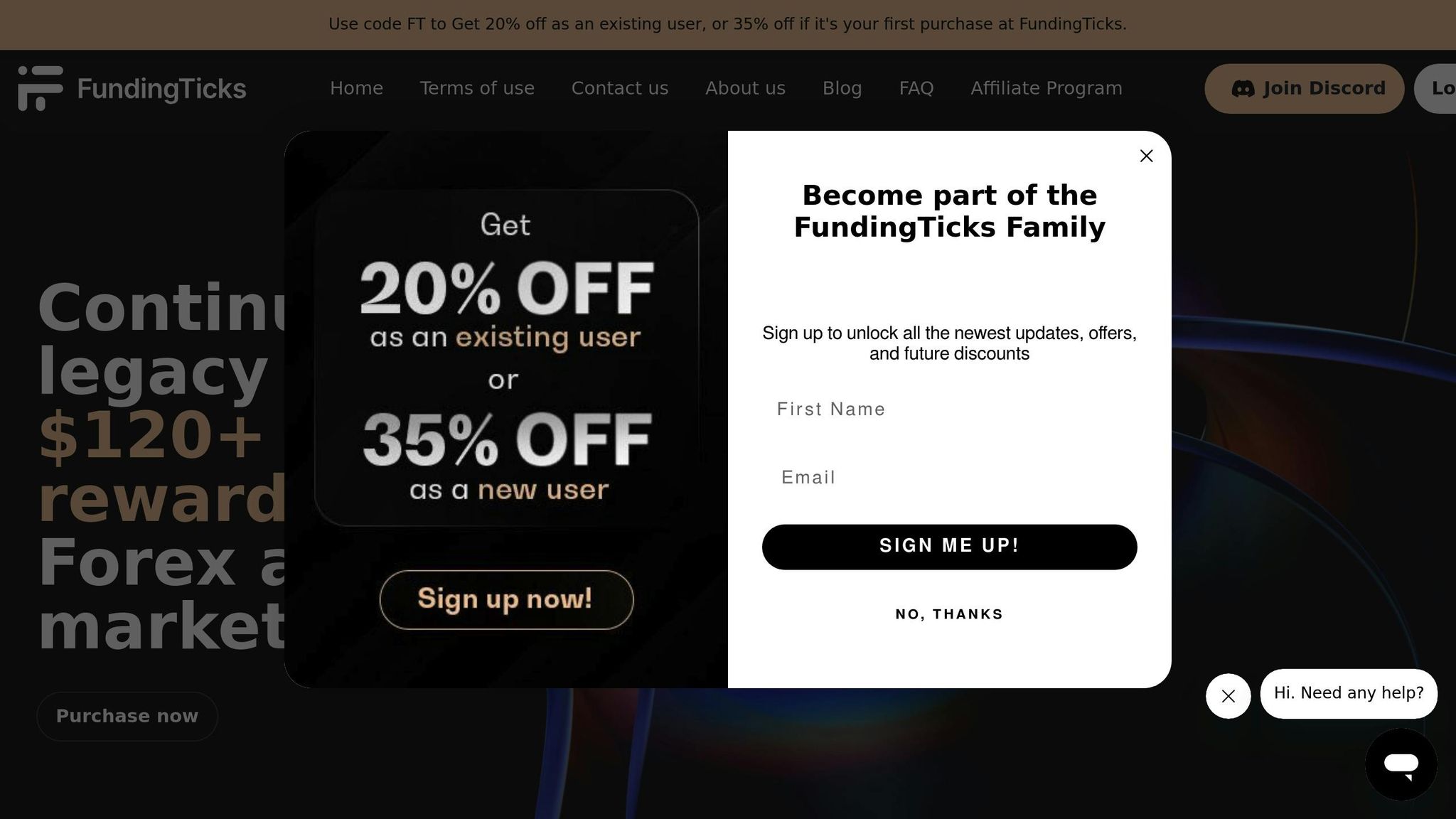
Set up in 2025 in the UAE, FundingTicks has fast earned a big name. With its cheap checks, quick green lights, and cash given out the same day, the platform makes it easy and quick for traders to jump in. Traders can pass the evaluation quickly, often in just one day, and start trading with real capital right away. This quick way has changed how new traders start, making it faster and easier than ever.
One of the standout features of FundingTicks is its focus on technology and infrastructure, enabling ultra-low latency trading which is crucial for futures traders who rely on speed and precision. The firm supports popular trading platforms such as NinjaTrader and TradeStation, ensuring seamless integration for various trading styles including discretionary and automated strategies. Additionally, FundingTicks offers flexible account options, catering to scalpers, day traders, and swing traders alike.
The firm’s transparent fee structure and clear trading rules help traders understand exactly what is expected, minimizing surprises during the evaluation and live trading phases. FundingTicks also emphasizes risk management by enforcing daily loss limits and maximum drawdowns, protecting both the trader and the firm’s capital.
Moreover, FundingTicks provides dedicated customer support available 24/7, assisting traders with any questions or technical issues promptly. The firm’s commitment to fast payouts, often within the same day, enhances traders’ cash flow and motivation.
Next, let’s look at how FXIFY Futures grows from this win.
2. FXIFY Futures
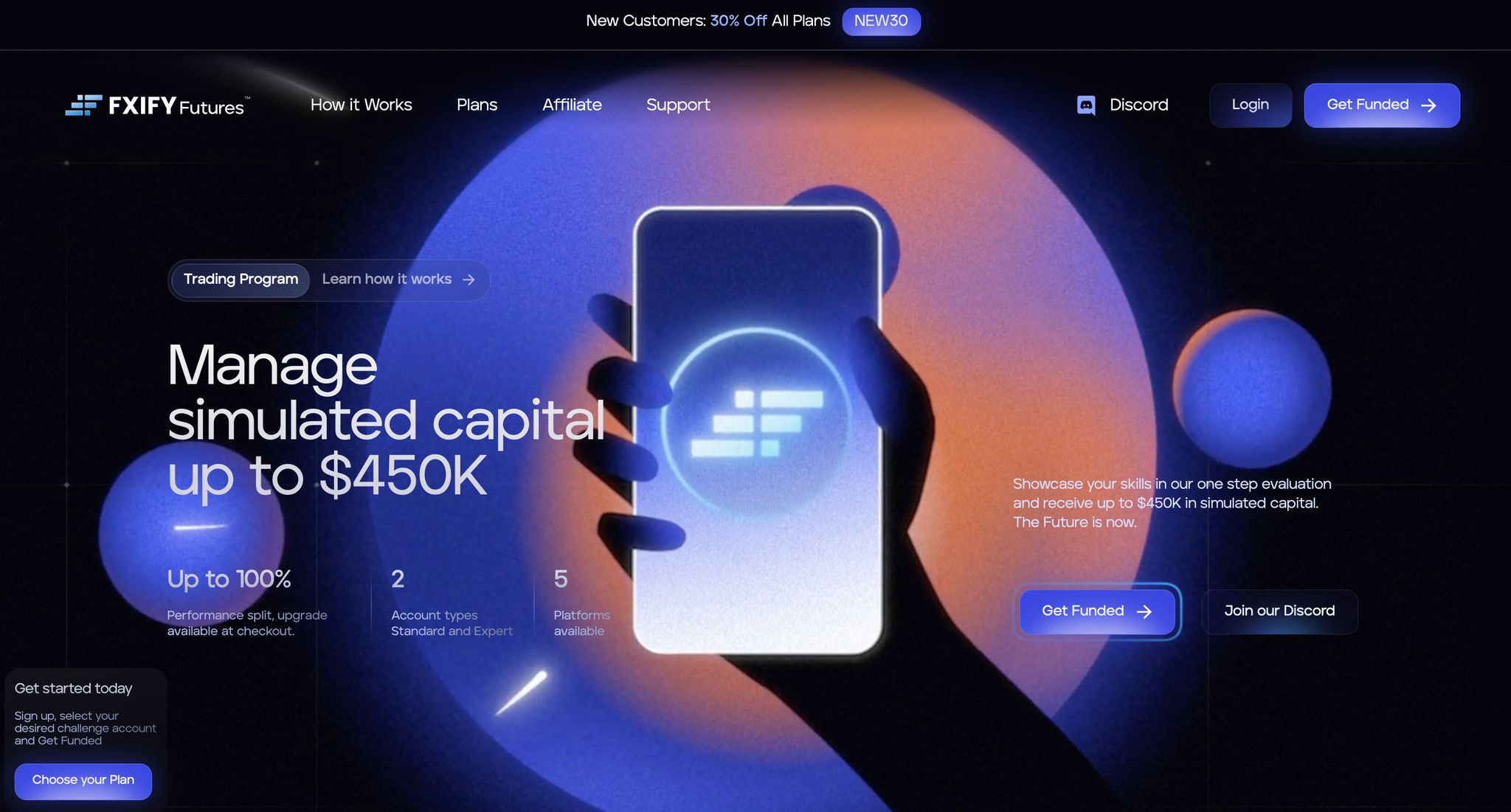
Founded in 2023 in the UK, FXIFY Futures has quickly gained recognition as a competitive futures prop firm. FXIFY offers a range of account sizes from $25,000 to $100,000 with evaluation fees between $89 and $349, making it accessible for traders with different budgets and experience levels.
One of FXIFY’s standout features is its immediate payout system, allowing funded traders to withdraw profits quickly and efficiently. The firm supports popular trading platforms and provides clear, straightforward rules to help traders understand the evaluation and live trading requirements.
FXIFY Futures emphasizes flexibility and trader support, with a focus on helping traders develop their skills through transparent communication and a user-friendly website. The firm’s competitive profit splits, typically ranging from 80% to 90%, make it an attractive choice for traders seeking a balance of opportunity and value.
| Account Size | Evaluation Fee | Payout Speed | Profit Split |
|---|---|---|---|
| $25,000 | $89 | Immediate | 80%-90% |
| $50,000 | $199 | Immediate | 80%-90% |
| $100,000 | $349 | Immediate | 80%-90% |
FXIFY Futures is a solid option for traders looking to join a growing prop firm with fast payouts, clear rules, and strong platform support.
Next, let’s look at how FundedNext Futures grows from this win.
3. FundedNext Futures
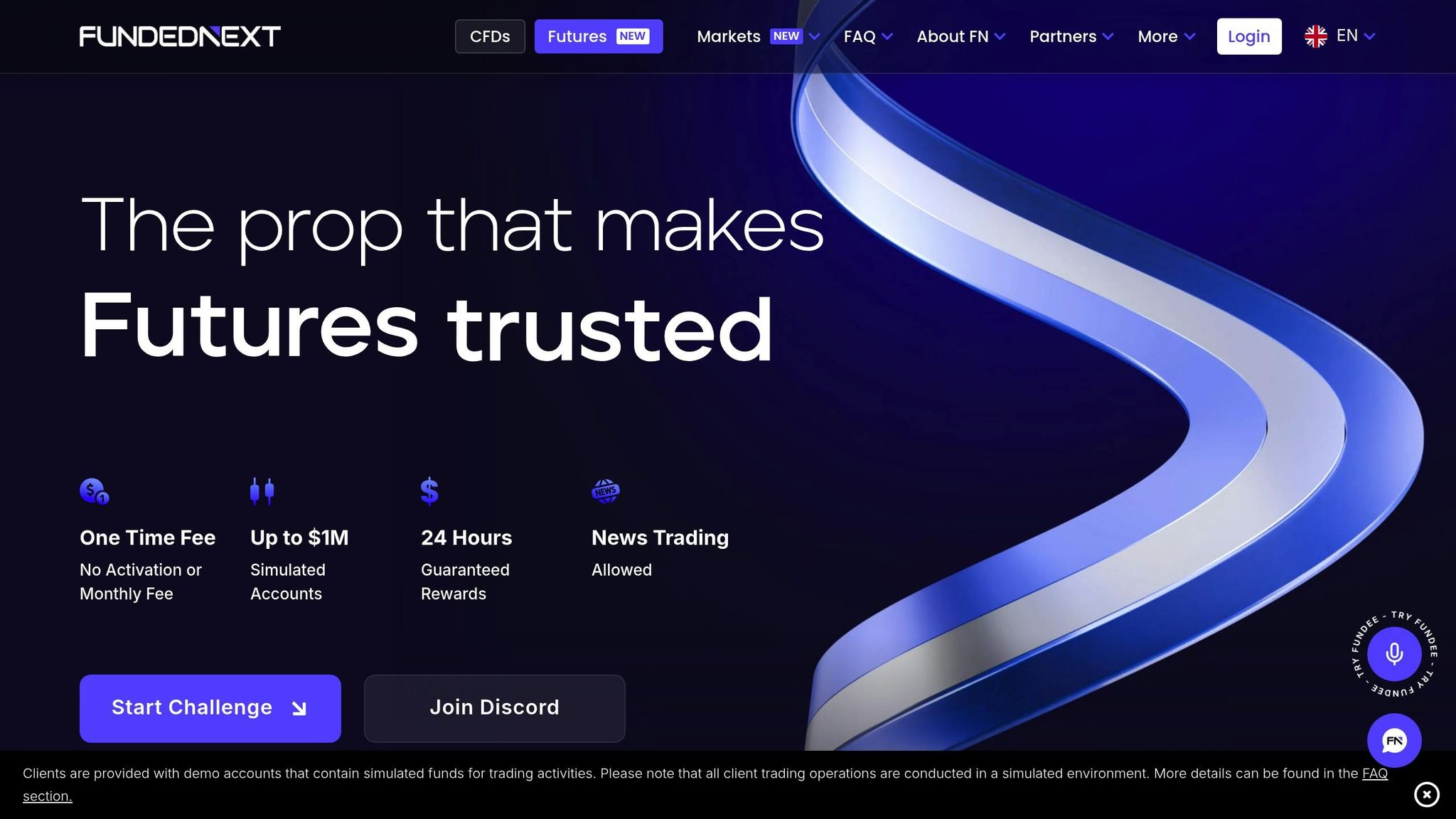
Set up in 2025 and based in the UAE, FundedNext Futures offers a clear, one-step test for traders. You can choose from three account sizes, each needing a one-time payment with no extra fees.
| Money in Account | Fee to Check One Time |
|---|---|
| $25,000 | $129 |
| $50,000 | $249 |
| $100,000 | $449 |
To start the evaluation process, traders simply complete and begin by submitting a straightforward online application or form.
To make the offer more fun, traders can grab some cuts in price. Put in the promo code ‘FNXTRADE’ when you sign up to get 30% off futures accounts. Also, if you need to start the run again, you get 10% off the fee to reset.
For those shifting from spot forex to futures, FundedNext Futures has an easy-to-use site set to ease the move and make it clear.
4. Tradeify

Set up in 2024 and based in the US, Tradeify is now well-known for its quick-funding style. This way, there’s no long check time, letting expert traders start using cash accounts right away – a big plus for those who want to cut the wait and just dive in. Once traders meet the firm’s requirements, they are paid promptly, ensuring quick and reliable payouts without delays.
Tradeify gives many cash account choices with easy costs and simple rules. The site works well with liked tools like NinjaTrader and TradeStation, and fits both hands-on and auto trade ways. It also backs outside VPS hosting to keep things running smooth and well.
Next up, see how My Funded Futures uses its strong US name to give even more to traders.
5. My Funded Futures

Introduced in 2023, My Funded Futures operates out of the United States and has quickly built a name for itself. With straightforward rules and dependable payout systems, it prioritizes simplicity for traders. Traders can expect to pay themselves or receive their earnings quickly and reliably, ensuring timely access to their funds. This approach has helped the platform establish a solid reputation among its users.
Following this, Take Profit Trader emphasizes consistent growth and positions itself as a mid-tier option for traders.
6. Take Profit Trader

Launched in 2021, Take Profit Trader has carved a niche for itself as a trusted mid-tier prop firm in the futures trading world. What makes this firm stand out is its focus on immediate profit withdrawals and a trader-friendly profit-sharing model that sets the bar high in the industry.
Traders can access account sizes of up to $150,000 after passing the firm’s evaluation process. To help traders manage risk and protect their accounts, Take Profit Trader enforces a daily loss limit, ensuring that losses are capped each day and accounts remain stable. With an 80% to 90% profit split, the bulk of the earnings stays with the trader, while the firm takes a smaller share for providing the necessary capital and infrastructure.
The evaluation process is designed to reward consistency. Instead of relying on a single big win, traders need to demonstrate steady performance over time. This consistency rule ensures that only disciplined and reliable traders move forward to manage live accounts. Once funded, traders benefit from the firm’s immediate withdrawal policy, allowing them to access their profits on a daily basis – a rare feature in the industry.
Take Profit Trader supports NinjaTraderandTradovate, two leading platforms known for professional-grade charting, order execution, and risk management tools. Additionally, the firm offers VPS services, which are particularly useful for traders running automated strategies or needing stable connections for uninterrupted trading.
| Feature | Details |
|---|---|
| Maximum Account Size | $150,000 |
| Profit Split | 80% – 90% to trader |
| Payout Frequency | Immediate withdrawals available |
| Supported Platforms | NinjaTrader, Tradovate |
Take Profit Trader has consistently earned its spot among the top five futures prop firms, with traders highlighting its fast payouts, generous profit splits, and straightforward evaluation process. For those navigating the US futures market, the firm provides a compelling mix of opportunity and risk control, backed by a strong reputation for reliability and trader support.
7. Topstep
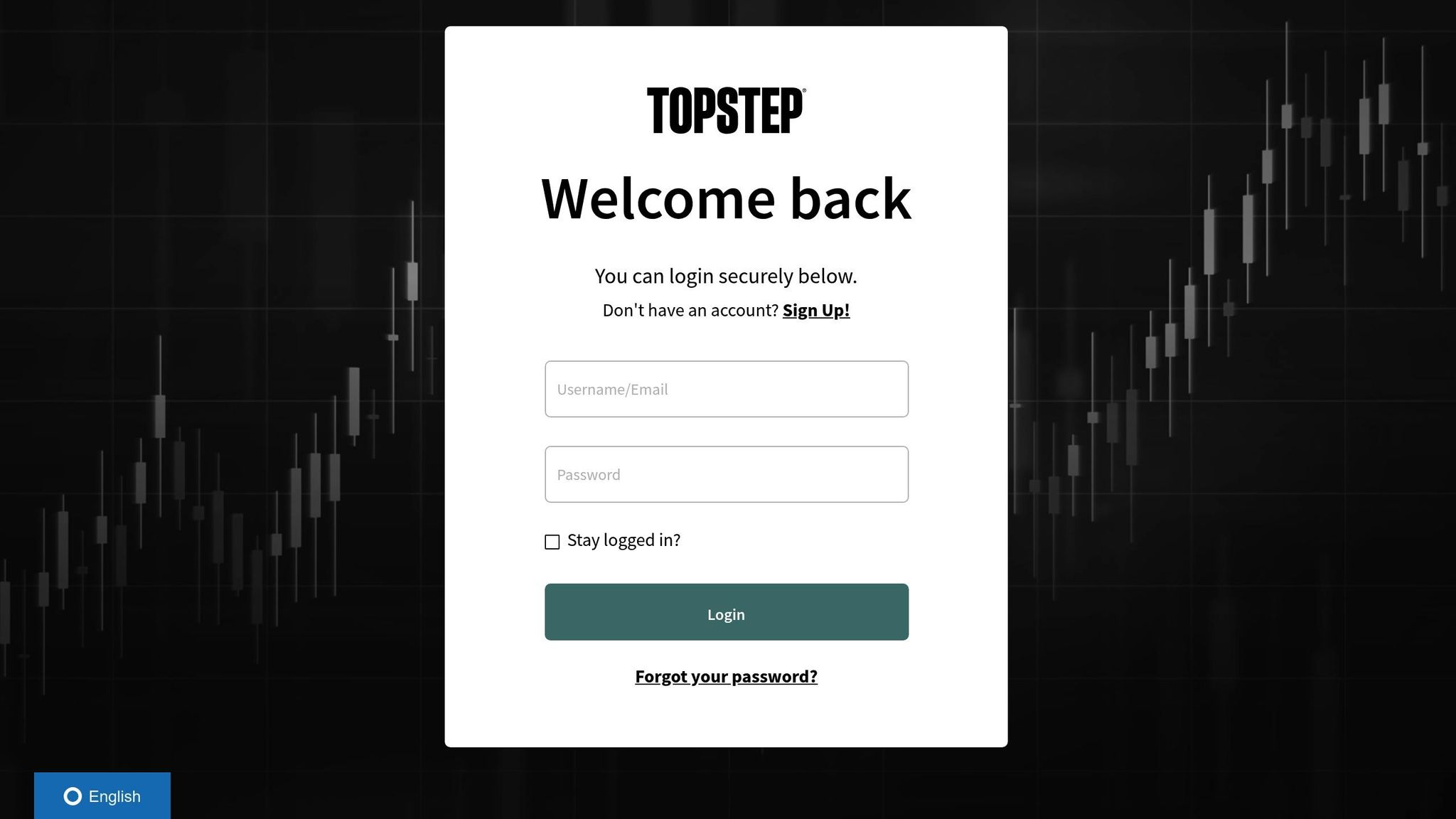
Since its launch in 2012, Topstep has built a reputation for reliability and a strong focus on trader education. With a solid foundation, Topstep offers structured plans designed to meet the needs of traders at every stage of their journey.
Topstep’s Trading Combine program comes in three tiers:
- Small Combine: A $50,000 account for $49 per month, perfect for beginners with less than six months of trading experience.
- Medium Combine: A $100,000 account priced at $99 per month, aimed at intermediate traders with 6–12 months of experience.
- Large Combine: A $150,000 account for $149 per month, tailored for experienced traders.
Topstep’s community is made up of real traders who share their experiences and support each other, adding to the platform’s credibility and authenticity.
Topstep also provides an Express Funded Account system, which allows traders to manage up to five accounts simultaneously. If an account remains inactive, its size can be adjusted within 72 hours. There’s a one-time activation fee of $149, and traders can opt for Level 2 market data at an additional $39 per month.
Here’s a quick breakdown of the Trading Combine plans:
| Account Size | Monthly Cost | Profit Target | Max Loss Limit | Contract Limit | Target Trader |
|---|---|---|---|---|---|
| $50,000 | $49 | $3,000 | $2,000 | 5 contracts | Beginners (< 6 months) |
| $100,000 | $99 | $6,000 | $3,000 | 10 contracts | Intermediate (6–12 months) |
| $150,000 | $149 | $9,000 | $4,500 | 15 contracts | Experienced traders |
The Trading Combine program is a hands-on way to refine trading skills and prepare for long-term success in the markets.
8. Lucid Trading
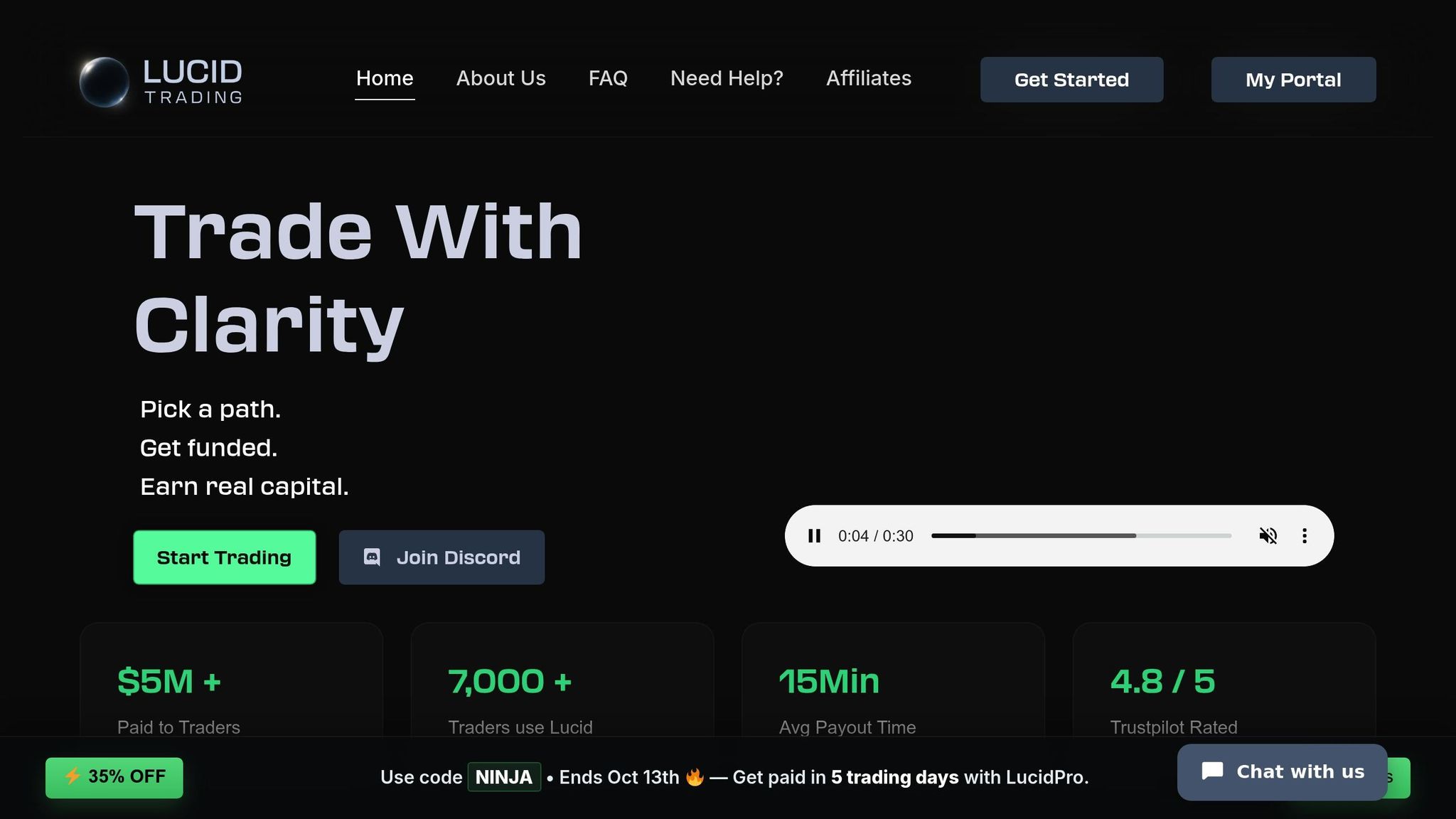
Lucid Trading stepped into the futures prop trading scene in 2025, offering a straightforward platform with transparent rules and quick withdrawals. The company has made a name for itself by providing traders with clear, upfront details about costs and requirements, making it an attractive option for both new and seasoned traders.
The firm offers four account tiers tailored to different experience levels:
- The $25,000 account starts at a $79 evaluation fee, making it a budget-friendly choice for newcomers.
- The $50,000 account requires a $139 evaluation fee.
- The $100,000 account is priced at $199.
- For experienced traders, the $150,000 account comes with a $299 evaluation fee.
One standout feature is the 80/20 profit split, which traders gain access to immediately after passing the evaluation. There are no scaling periods or extra hurdles to unlock the full percentage, ensuring traders can start earning their share without delays.
When it comes to payouts, Lucid Trading keeps things simple and fast. Most traders can request weekly withdrawals, while experienced traders benefit from same-day payouts. This quick turnaround is ideal for those who want to reinvest their profits without waiting.
Lucid Trading integrates with major platforms like NinjaTrader and Tradovate, offering direct market access and full support for both discretionary and algorithmic trading strategies. To ensure smooth operations, the platform is compatible with major VPS hosts, providing 24/7 uptime and low latency.
| Account Size | Evaluation Fee | Profit Split | Payout Schedule |
|---|---|---|---|
| $25,000 | $79 | 80/20 | Weekly/Same-day |
| $50,000 | $139 | 80/20 | Weekly/Same-day |
| $100,000 | $199 | 80/20 | Weekly/Same-day |
| $150,000 | $299 | 80/20 | Weekly/Same-day |
Traders have also praised Lucid Trading’s responsive support team and its modern dashboard, which makes navigating the platform a breeze. The evaluation process aligns with industry standards, featuring clear profit targets and drawdown limits. What sets Lucid apart is its transparency – traders know exactly what’s expected from the start, eliminating any guesswork.
With Lucid Trading’s transparent rules and fast payouts, traders can’t go wrong choosing this platform.
Although Lucid Trading is a newer player in the market and lacks the long history of more established firms, early reviews highlight its dedication to fast payouts and open communication, making it a promising choice for futures traders.
9. TradeDay
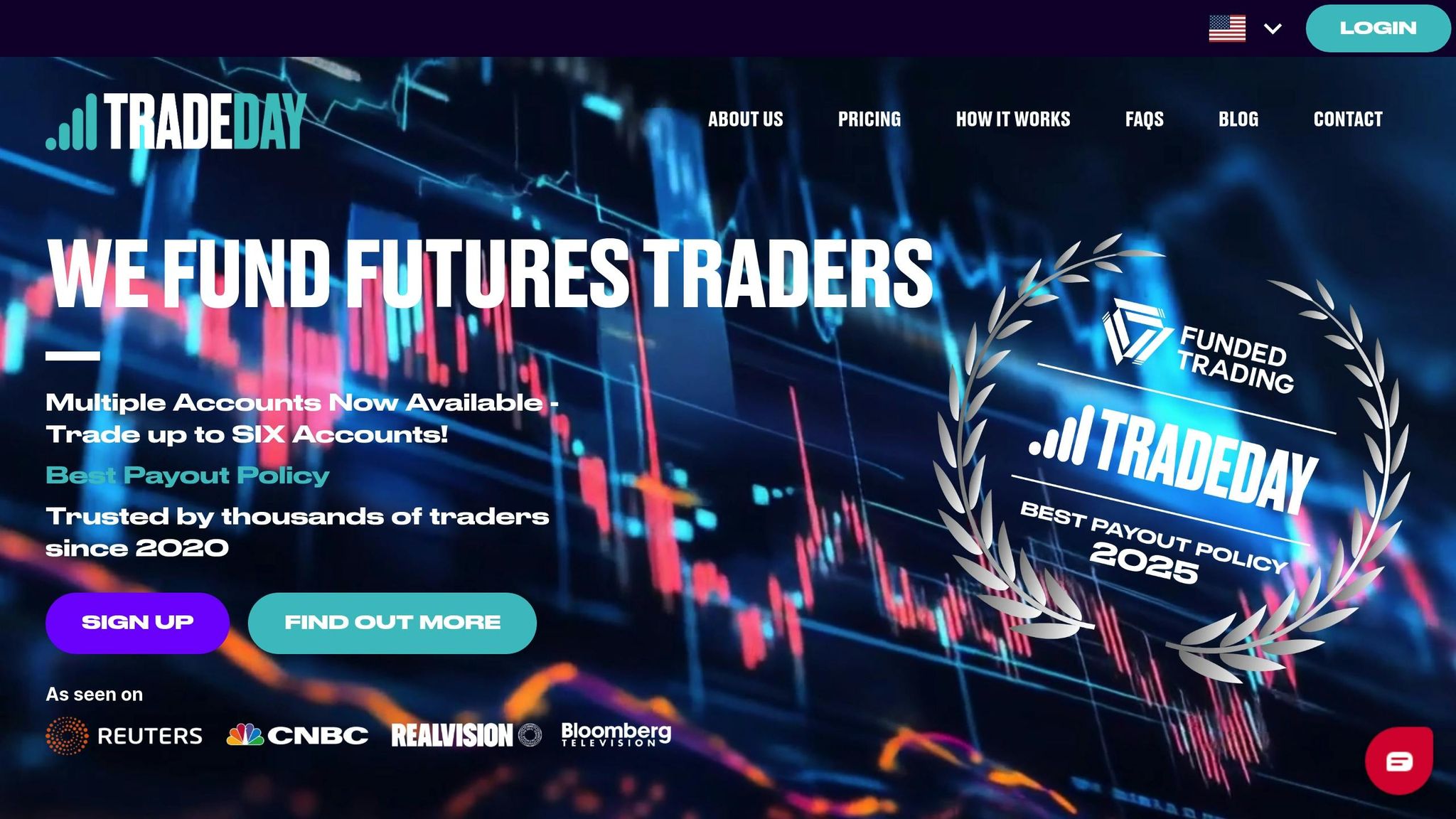
Founded in 2020, TradeDay has made a name for itself in the futures prop trading world. They focus on providing strong coaching and support systems designed to help traders refine their skills and achieve long-term success. TradeDay also works with trusted partners to offer additional resources and support for traders. Up next, let’s see how Apex Trader Funding takes these industry principles to the next level.
10. Apex Trader Funding
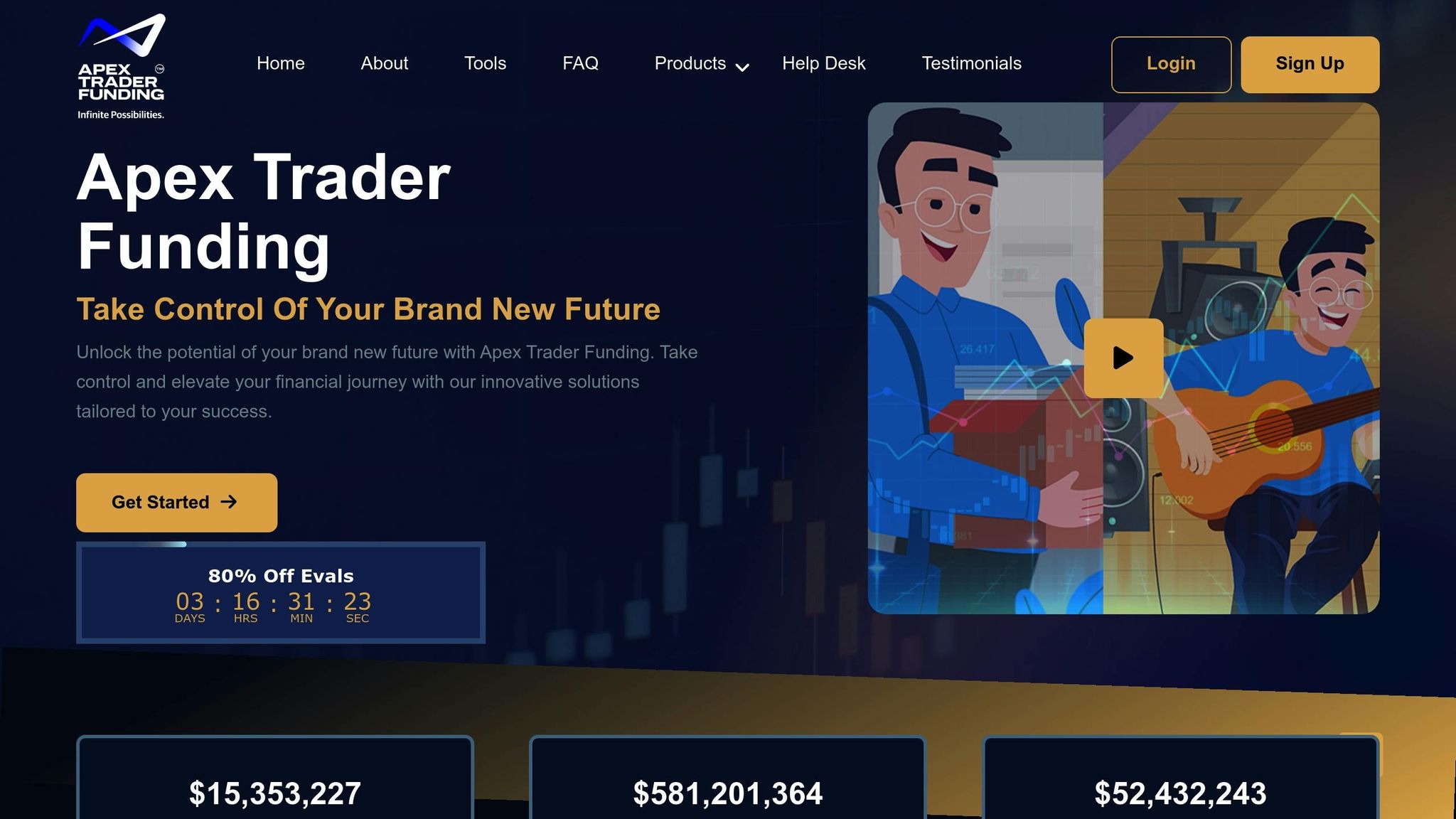
Launched in 2021, Apex Trader Funding has quickly gained attention with its flexible account options and frequent promotional discounts, making it appealing to both beginners and seasoned traders.
The company keeps things simple with a transparent evaluation process that includes clear risk and profit targets. For traders who need another shot, their reset policy offers discounted options, giving participants a chance to try again without breaking the bank.
Apex Trader Funding also emphasizes community. They host an active online forum where traders can exchange strategies, market insights, and personal experiences. This collaborative space allows newcomers to learn from experienced traders and form connections within the trading world. Plus, their customer support team is available through multiple channels, ensuring traders get the help they need when they need it.
The benefits of Apex Trader Funding include flexible account options that cater to different trading styles and an active community that provides ongoing support and shared learning opportunities.
11. The Futures Desk (UK) [BONUS]

The Futures Desk in the UK offers four evaluation account sizes tailored to different trader needs: Starter ($25,000), Popular ($50,000), Premium ($100,000), and Pro ($200,000). Each account comes with a transparent fee structure, summarized under a “True Cost” model.
For example, the Popular $50,000 account has a total cost of $204, which includes a $29 monthly fee, a $129 one-time fee, and a $75 activation fee. The Starter account is priced at $134, while the Pro account totals $539.
| Account Size | Monthly Fee | One-time Fee | Activation Fee | True Cost |
|---|---|---|---|---|
| $25,000 (Starter) | $29 | $59 | $75 | $134 |
| $50,000 (Popular) | $29 | $129 | $75 | $204 |
| $100,000 (Premium) | $29 | $169 | $75 | $244 |
| $200,000 (Pro) | $29 | $389 | $150 | $539 |
This straightforward fee breakdown ensures clarity for traders and highlights how The Futures Desk integrates its trading technology to support prop trading operations effectively.
Prop Trading Challenge Overview
The prop trading challenge is a key step in the journey to becoming a funded trader. This challenge is designed to test a trader’s skills, discipline, and risk management abilities in a simulated funded account. During the challenge, traders must reach a specific profit target while following strict risk management rules—such as daily loss limits and maximum drawdowns—set by the prop firm. The challenge account serves as a proving ground, allowing traders to demonstrate their ability to trade consistently and responsibly.
Successfully completing the trading challenge is often the gateway to a live funded account, where traders can access real capital and start earning daily payouts based on their performance. The challenge is an essential part of most trading programs, as it helps prop firms identify traders who have the right mix of trading skills, strategy, and risk control. By progressing through the challenge and into a live account, traders move closer to their goal of trading professionally, managing larger accounts, and building a track record of trading success.
Trading Account Types
Prop firms offer a range of trading account types to suit different trading approaches and experience levels. The most common options include simulated funded accounts, live funded accounts, and cash accounts. Each account type comes with its own set of rules, profit targets, and risk management parameters.
For example, a simulated funded account is typically used during the evaluation or challenge phase, where traders must meet specific profit targets and adhere to strict risk management guidelines. Once a trader passes the challenge, they may be upgraded to a live funded account, which allows them to trade with real capital and potentially access higher leverage and larger profit opportunities. Cash accounts are another option, often providing more flexibility and immediate access to profits.
Traders can select the account type that best matches their trading strategy, risk tolerance, and goals. Some prop firms also offer accounts with varying activation fees, leverage options, and daily loss limits, giving traders even more control over their trading journey. By understanding the differences between account types, traders can choose the path that aligns with their approach to the markets and maximizes their chances of long-term success.
Trader Eligibility
To become a funded trader with a prop firm, individuals must meet certain eligibility requirements. These criteria are designed to ensure that traders are prepared to handle the responsibilities of managing a funded account and can follow the firm’s risk management rules. Common requirements include being of legal age, meeting residency or geographic restrictions, and having a basic level of trading experience.
In most cases, traders must also agree to the prop firm’s terms and conditions, which outline the rules of the trading program and the expectations for risk management. Completing a trading challenge or evaluation is often a prerequisite for moving from a challenge account to a live funded account. The evaluation process helps the firm assess a trader’s ability to manage risk, follow rules, and achieve consistent results.
Eligibility requirements may vary depending on the account type and the specific prop firm, so it’s important for traders to review all guidelines before applying. By meeting these standards, traders can demonstrate their readiness to manage real capital and take the next step toward becoming a funded trader.
Trading Strategy: Building Your Edge
A well-defined trading strategy is the foundation of long-term trading success with a prop firm. Building your edge means developing a set of rules and guidelines that guide your trading decisions, from when to enter and exit trades to how you manage risk and adapt to changing market conditions. Successful traders invest time in backtesting their ideas, analyzing market data, and refining their trading skills to stay ahead of the curve.
Risk management is a critical component of any trading strategy, helping traders protect their capital and maintain consistent performance. Prop firms often provide access to valuable resources—such as trading insights, market analysis, and risk management tools—to support traders in building and executing their strategies. By leveraging these resources and maintaining a disciplined approach, traders can improve their performance, gain confidence, and increase their chances of becoming a funded trader.
Ultimately, combining a solid trading strategy with the support and structure of a prop firm gives traders a clear path to success. With the right plan, ongoing learning, and a commitment to following the rules, traders can develop the skills needed to thrive in the competitive world of futures trading.
Trading Technology Infrastructure for Futures Prop Firms
Futures prop trading thrives on a solid foundation of technology – spanning hardware, software, connectivity, and hosting – that ensures fast execution and effective risk management. For firms in this space, the quality of their tech infrastructure directly impacts how quickly trades are executed, the reliability of their systems, and their ability to scale operations smoothly.
In futures markets, even a delay of milliseconds can determine whether a trade hits its mark or an opportunity is lost. Stable and secure technology reduces slippage and downtime, giving traders the edge they need to seize market opportunities. This intense demand for speed and dependability highlights why VPS hosting has become essential.
The VPS Advantage for Futures Trading
Virtual Private Server (VPS) hosting has emerged as the go-to solution for serious futures prop traders. Unlike local computer setups, VPS hosting offers remote servers strategically located near major exchange data centers. This proximity ensures ultra-low latency connections to trading platforms, significantly cutting down order execution times. It also minimizes risks like internet outages or power failures and supports 24/7 automated trading. On top of that, VPS hosting adds an extra layer of security.
Beyond speed, reliability is critical, especially when managing funded accounts with strict drawdown limits. A single internet disruption or power failure during a key market move could lead to substantial losses, potentially breaching a prop firm’s trading rules.
Key Infrastructure Requirements
For US-based futures traders, ultra-low latency (0-1ms) to major exchanges like the CME is non-negotiable. A 100% uptime guarantee ensures uninterrupted market access, even during volatile sessions. To guard against cyber threats, DDoS protection is vital, shielding connections from attacks that could disrupt trading at critical moments.
Another important factor is platform compatibility. Futures prop firms often rely on platforms such as NinjaTrader, MetaTrader, and TradeStation. A VPS provider must support these platforms seamlessly, ensuring smooth performance for multiple chart configurations and automated strategies.
QuantVPS: Tailored for US Futures Traders
QuantVPS has carved out a niche as a VPS solution designed specifically for US futures traders. Founded by Ethan Brooks, the service delivers ultra-low latency of 0-1ms and guarantees 100% uptime, meeting the stringent demands of prop traders who operate under high-performance requirements.
The platform offers full compatibility with widely-used trading platforms like NinjaTrader, MetaTrader, and TradeStation. It also includes critical features such as DDoS protection and automatic backups, safeguarding operations from cyber threats and data loss.
QuantVPS provides flexible plans to cater to various trading needs:
- VPS Lite: Priced at $59.99/month (or $41.99 annually), this plan includes 4 cores, 8GB RAM, and 70GB NVMe storage, ideal for traders managing 1-2 charts.
- VPS Pro: At $99.99/month (or $69.99 annually), this plan offers 6 cores, 16GB RAM, and 150GB NVMe storage with dual monitor support, making it suitable for 3-5 charts.
- Dedicated Server: For $299.99/month (or $209.99 annually), this option delivers 16+ dedicated cores, 128GB RAM, and 2TB+ NVMe storage, supporting up to 6 monitors – perfect for high-volume operations.
These plans not only enhance performance but also reduce risks that might otherwise derail trading success.
Infrastructure Impact on Trading Performance
The importance of a strong technology stack cannot be overstated. Poor infrastructure introduces risks like slippage, missed trades, and increased vulnerability to cyberattacks. For example, system outages during high-stakes moments can lead to major drawdowns or even account liquidations.
This becomes even more critical as traders scale from smaller evaluation accounts to larger funded ones. A trader who passes a $25,000 evaluation but encounters technical issues on a $100,000 funded account faces significantly higher dollar risks from the same percentage drawdown.
Recognizing this, many modern futures prop firms now factor technology requirements into their trader evaluations. They understand that consistent profitability relies not just on trading skills, but also on reliable execution infrastructure. As a result, professional-grade VPS hosting has shifted from being a luxury to an absolute necessity for those serious about prop trading.
Investing in top-tier infrastructure pays off through better fill rates, reduced technical headaches, and the freedom to focus on market analysis rather than worrying about connectivity. For US futures prop traders, choosing a VPS provider with proven performance and platform compatibility is a critical step that can shape the success of every trade that follows.
Comparison Table
Here’s a quick look at the pricing and account sizes offered by FundingTicks. Keep in mind that details for other firms may vary.
| Firm | Account Sizes | Evaluation Fees |
|---|---|---|
| FundingTicks | $25K, $50K, $100K | Pro+: $99–$199/month; Zero: $333–$599 (one-time); One: $112–$177/month |
Note: Pricing and account size details for other futures prop firms may change over time.
Key Pricing Insights
FundingTicks offers a range of pricing options to suit different trader preferences. For those looking for a low-cost entry, the Pro+ monthly plan starts at $99 for a $25,000 account. If you prefer a one-time evaluation fee, the Zero program is available for $333 to $599. Meanwhile, the One program provides a balance between the two, with monthly fees ranging from $112 to $177. These flexible plans make it easier for traders to choose an option that aligns with their goals. Additionally, strong tech support can play a crucial role in improving trading outcomes.
Technology Infrastructure Considerations
Most futures prop firms integrate seamlessly with popular trading platforms like NinjaTrader and TradingView, which are often used alongside VPS hosting for better performance. A standout option for VPS hosting is QuantVPS, offering ultra-low latency (0–1 ms) and guaranteed 100% uptime. Their VPS Pro plan, priced at $99.99/month (or $69.99/month with annual billing), includes 6 cores and 16 GB of RAM – perfect for running setups with 3–5 charts smoothly.
Payout Frequency and Platform Compatibility
Daily payouts can be a game-changer for active traders, improving cash flow and financial flexibility. QuantVPS supports major trading platforms like NinjaTrader, MetaTrader, and TradeStation, ensuring compatibility across multiple funded accounts. Features like automatic backups and DDoS protection provide added security and reliability for seamless trading operations.
Conclusion
Choosing the right futures prop firm comes down to a few critical factors: clear evaluations, fair profit splits, and reliable trading infrastructure. These elements are essential for maintaining steady cash flow and managing risk effectively.
Quick and dependable payouts are crucial for ensuring smooth cash flow and allowing traders to reinvest without delays. Evaluation processes also vary widely – some firms offer unlimited time to meet targets, giving traders the freedom to refine their strategies without the added pressure of tight deadlines.
Technology plays a pivotal role in trading success. Reliable systems prevent delays and outages that could lead to costly errors like slippage or unexpected losses. When a firm offers seamless technology and efficient payout systems, it directly enhances trading performance.
For example, QuantVPS provides ultra-low latency (0–1ms) and guarantees 100% uptime. It supports major platforms and includes essential features like DDoS protection and automatic backups, ensuring smooth and secure operations.
The industry is also shifting toward more trader-friendly options, such as instant funding, flexible programs, and user-friendly platforms. Firms like Lucid Trading are raising the bar with transparent rules and intuitive interfaces, while long-standing names like Topstep continue to earn trust through stability and extensive educational resources.
Ultimately, success in futures prop trading hinges on aligning your trading style with a firm that offers the right combination of rules, flexibility, and infrastructure. Whether your priority is same-day payouts, larger account sizes, or a more relaxed evaluation process, the key is to find a firm that supports your goals and provides the tools you need to execute your strategies effectively. This alignment is the foundation for consistent success in the competitive world of futures trading.
FAQs
What are the advantages of choosing UAE-based futures prop firms like FundingTicks or FundedNext Futures compared to U.S.-based firms?
Choosing a futures prop firm based in the UAE, such as FundingTicks or FundedNext Futures, comes with some compelling perks compared to their U.S.-based counterparts. The UAE’s pro-business environment makes things easier with quicker setup processes, flexible ownership options, and straightforward regulatory guidelines – helping both traders and firms operate more smoothly.
On top of that, the UAE’s prime location, appealing tax policies, and lower overhead costs make it an attractive base for prop trading firms aiming to grow. These advantages often lead to faster approvals, competitive pricing, and potentially better trading conditions than what’s typically found in the more tightly regulated and often pricier U.S. market.
Why is VPS hosting important for futures prop traders, and how does it improve trading performance?
VPS hosting plays a key role for futures prop traders by offering a stable and low-latency connection to trading platforms. This setup ensures trades are executed swiftly and without interruptions. In the world of high-speed trading, even a fraction of a second can make a big difference in profitability, so having a reliable connection is non-negotiable.
Another advantage of VPS hosting is its ability to keep trading software running around the clock. Even if your local internet goes down or there’s a power outage, the VPS ensures uninterrupted market access and consistent execution speeds. This reliability can be a game-changer in fast-paced trading environments.
What should I look for when choosing a futures prop firm that fits my trading style and goals?
When selecting a futures prop firm, it’s crucial to weigh a few key elements to ensure you’re making the right choice. Start by examining the firm’s reputation, track record, and regulatory compliance – these factors can give you confidence in their reliability and trustworthiness.
Next, take a close look at their fee structure, profit-sharing model, and payout policies. These should match your financial objectives and fit within your risk tolerance. After all, a misaligned structure could impact your profitability.
You’ll also want to assess their trading instruments, platform features, and risk management rules to see if they suit your trading style. Lastly, firms that provide robust customer support and educational resources can be a game-changer, offering tools to help you grow and refine your trading skills. By aligning these factors with your personal goals, you’ll set yourself up for long-term success.








